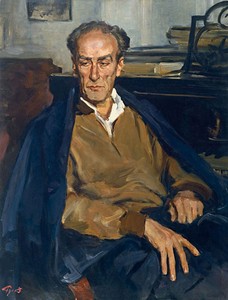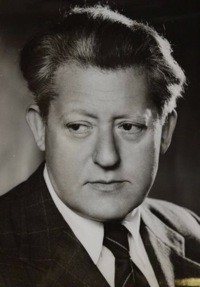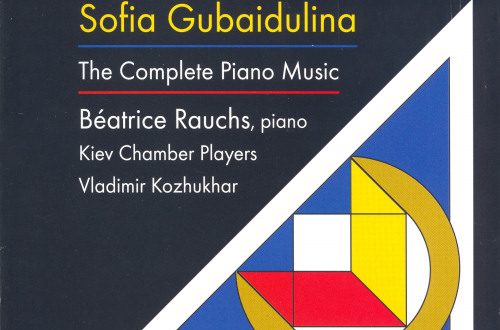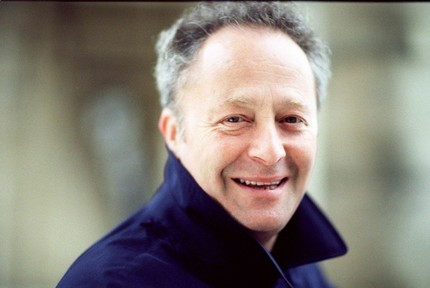
Evgeny Alexandrovich Mravinsky |
Evgeny Mravinsky

People’s Artist of the USSR (1954). Laureate of the Lenin Prize (1961). Hero of Socialist Labor (1973).
The life and work of one of the greatest conductors of the 1920th century are inextricably linked with Leningrad. He grew up in a musical family, but after graduating from a labor school (1921) he entered the natural faculty of Leningrad University. By that time, however, the young man was already associated with the musical theater. The need to earn money brought him to the stage of the former Mariinsky Theater, where he worked as a mime. This very boring occupation, meanwhile, allowed Mravinsky to expand his artistic horizons, to gain vivid impressions from direct communication with such masters as singers F. Chaliapin, I. Ershov, I. Tartakov, conductors A. Coates, E. Cooper and others. In further creative practice, he was served well by the experience gained while working as a pianist at the Leningrad Choreographic School, where Mravinsky entered in XNUMX. By this time, he had already left the university, deciding to devote himself to professional musical activity.
The first attempt to enter the conservatory was unsuccessful. In order not to waste time, Mravinsky enrolled in the classes of the Leningrad Academic Chapel. Student years began for him in the following year, 1924. He takes courses in harmony and instrumentation with M. Chernov, polyphony with X. Kushnarev, form and practical composition with V. Shcherbachev. Several works by the beginning composer were then performed in the Small Hall of the Conservatory. Nevertheless, the self-critical Mravinsky is already looking for himself in a different field – in 1927 he began conducting classes under the guidance of N. Malko, and two years later A. Gauk became his teacher.
Striving for the practical development of conducting skills, Mravinsky devoted some time to work with the amateur symphony orchestra of the Union of Soviet Trade Employees. The first public performances with this group included works by Russian composers and earned positive reviews from the press. At the same time, Mravinsky was in charge of the musical part of the choreographic school and conducted here Glazunov’s ballet The Four Seasons. In addition, he had an industrial practice at the Opera Studio of the Conservatory. The next stage of Mravinsky’s creative development is associated with his work at the Opera and Ballet Theater named after S.M. Kirov (1931-1938). At first he was an assistant conductor here, and a year later he made his independent debut. It was September 20, 1932. Mravinsky conducted the ballet “Sleeping Beauty” with the participation of G. Ulanova. The first great success came to the conductor, which was consolidated by his next works – Tchaikovsky’s ballets “Swan Lake” and “The Nutcracker”, Adana “Le Corsaire” and “Giselle”, B. Asafiev “The Fountain of Bakhchisarai” and “Lost Illusions”. Finally, here the audience got acquainted with the only opera performance by Mravinsky – “Mazepa” by Tchaikovsky. So, it seemed that the talented musician finally chose the path of theatrical conducting.
The All-Union Competition of Conductors in 1938 opened a new magnificent page in the artist’s creative biography. By this time, Mravinsky had already accumulated considerable experience in the symphony concerts of the Leningrad Philharmonic. Especially important was his meeting with the work of D. Shostakovich during the decade of Soviet music in 1937. Then the Fifth Symphony of the outstanding composer was performed for the first time. Shostakovich later wrote: “I got to know Mravinsky most closely during our joint work on my Fifth Symphony. I must confess that at first I was somewhat frightened by Mravinsky’s method. It seemed to me that he delved too much into trifles, paid too much attention to particulars, and it seemed to me that this would damage the general plan, the general idea. About every tact, about every thought, Mravinsky made me a real interrogation, demanding from me an answer to all the doubts that arose in him. But already on the fifth day of working together, I realized that this method is definitely the right one. I began to take my work more seriously, watching how seriously Mravinsky works. I realized that a conductor should not sing like a nightingale. Talent must first of all be combined with long and painstaking work.
Mravinsky’s performance of the Fifth Symphony was one of the highlights of the competition. The conductor from Leningrad was awarded the first prize. This event largely determined the fate of Mravinsky – he became the chief conductor of the symphony orchestra of the Leningrad Philharmonic, now a well-deserved ensemble of the republic. Since then, there have been no noticeable external events in Mravinsky’s life. Year after year, he nurtures the led orchestra, expanding its repertoire. While honing his skills, Mravinsky gives magnificent interpretations of Tchaikovsky’s symphonies, works by Beethoven, Berlioz, Wagner, Brahms, Bruckner, Mahler and other composers.
The peaceful life of the orchestra was interrupted in 1941, when, by government decree, the Leningrad Philharmonic was evacuated to the east and opened its next season in Novosibirsk. In those years, Russian music occupied a particularly significant place in the conductor’s programs. Along with Tchaikovsky, he performed works by Glinka, Borodin, Glazunov, Lyadov… In Novosibirsk, the Philharmonic gave 538 symphony concerts attended by 400 people…
Mravinsky’s creative activity reached its peak after the return of the orchestra to Leningrad. As before, the conductor performs at the Philharmonic with rich and varied programs. An excellent interpreter is found in him by the best works of Soviet composers. According to the musicologist V. Bogdanov-Berezovsky, “Mravinsky developed his own individual style of performance, which is characterized by a close fusion of emotional and intellectual principles, temperamental narration and a balanced logic of the overall performance plan, developed by Mravinsky primarily in the performance of Soviet works, the promotion of which he gave and gives a lot of attention”.
Mravinsky’s interpretation was used for the first time by many works by Soviet authors, including Prokofiev’s Sixth Symphony, A. Khachaturian’s Symphony-Poem, and, above all, the outstanding creations of D. Shostakovich, included in the golden fund of our musical classics. Shostakovich entrusted Mravinsky with the first performance of his Fifth, Sixth, Eighth (dedicated to the conductor), Ninth and Tenth symphonies, the oratorio Song of the Forests. It is characteristic that, speaking of the Seventh Symphony, the author emphasized in 1942: “In our country, the symphony was performed in many cities. Muscovites listened to it several times under the direction of S. Samosud. In Frunze and Alma-Ata, the symphony was performed by the State Symphony Orchestra, led by N. Rakhlin. I am deeply grateful to Soviet and foreign conductors for the love and attention they have shown to my symphony. But it sounded most close to me as the author, performed by the Leningrad Philharmonic Orchestra conducted by Evgeny Mravinsky.
There is no doubt that it was under the leadership of Mravinsky that the Leningrad orchestra grew into a world-class symphony ensemble. This is the result of the conductor’s tireless work, his indefatigable desire to search for new, most profound and accurate readings of musical works. G. Rozhdestvensky writes: “Mravinsky is equally demanding of himself and of the orchestra. During joint tours, when I had to hear the same works many times over a relatively short period of time, I was always surprised by the ability of Evgeny Alexandrovich not to lose the feeling of their freshness with repeated repetition. Every concert is a premiere, before every concert everything has to be re-rehearsed. And how difficult it is sometimes!
In the post-war years, international recognition came to Mravinsky. As a rule, the conductor goes on tour abroad together with the orchestra he leads. Only in 1946 and 1947 he was a guest of the Prague Spring, where he performed with Czechoslovak orchestras. The performances of the Leningrad Philharmonic in Finland (1946), Czechoslovakia (1955), Western European countries (1956, 1960, 1966), and the United States of America (1962) were a triumphant success. Crowded halls, applause from the public, enthusiastic reviews – all this is recognition of the first-class skill of the Leningrad Philharmonic Symphony Orchestra and its chief conductor Evgeny Aleksandrovich Mravinsky. The pedagogical activity of Mravinsky, a professor at the Leningrad Conservatory, also received well-deserved recognition.
L. Grigoriev, J. Platek, 1969





